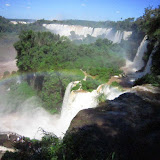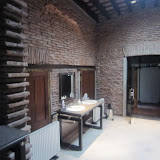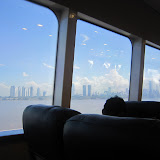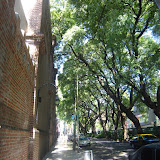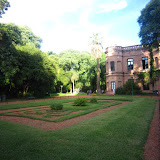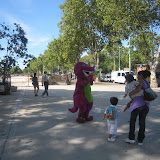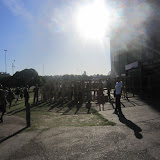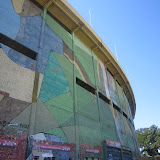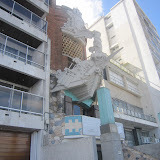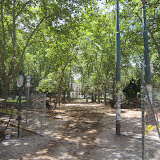I'm back on terra firma after three days spent on a boat and off the radar. My mind is officially blown. The things we saw were absolutely spectacular, and I'm realizing that I'm rapidly running out of superlatives to describe my experiences on this trip. I think I have a lot less insight to offer into things when it's just "this naturally-occuring phenomenon is awesome" and there's not any cultural stuff involved, but I'll take you through my time aboard the Mare Australis.
The first day began with a sunrise stop at Cape Horn, the southernmost point in the world--not including Antarctica. The view from the largely unspoilt cliffs of Isla de Hornos out over the vast southern seas was one in a long string of glimpses of the humbling power of nature. From there we headed over to Wulaia Bay, where we disembarked and hiked up a hill to a viewpoint. It was up there that I turned to Todd and Valerie, possibly the only other people on the boat traveling with a backpack, and said "yeah, I think I'm starting to understand this whole Patagonia thing." I took some massive panoramic photos up there if you're curious as to what I mean.
Wulaia Bay also offered some excellent wildlife sightings. Patagonia is one of the few places in the world where the most aggressive resident is Canadian. And indeed, on the way up the hill, we saw many telltale signs of beavers, and eventually caught a glimpse of one swimming around its dam. Beavers were brought to Patagonia from Canada over 100 years ago in the hopes of giving the area a fur industry as strong as its wool trade. Apparently, however, beaver fur requires stressed-out beavers--the adrenaline makes the fur usable somehow through the magic of endocrinology. The beavers in Patagonia found the region much more accommodating than Canada had been, and instead of providing a stressed-out foundation for the economy, they grew from a population of 50 to about 50,000. Seriously people. Stop bringing invasive species to places because you think you're smarter than millions of years of evolution. I don't care how adorable they are. It messes things up. Though, that said, the beaver was adorable. On the zodiac boats back to the ship (yes, I do feel like a character from LOST), a few dolphins swam around us and jumped around in the water. I got one decent video of them and a whole lot of videos of looking for them.
Day two involved a drip to the Alacalufe Fjord in Chico Inlet, where we got to take zodiacs over to Nena and Piloto Glaciers. This was where I learned that glaciers and the fjords they create are some pretty impressive geographical formations (understatement alert). What's completely daunting is the total loss of spatial perspective. You sit in a boat next to this enormous thing, but you're far enough away that it's tough to tell how far away you are, and just how massive the thing is. Our guide said the glacier runs about 1800 meters up to an ice field. It's basically the world's largest freezer.
The glaciers were comprised of mostly blue ice--meaning that the ice is very old and has spent centuries being compacted by the glacier's enormous weight. On that particular day, there had been a tremendous amount of calving, which happens when part of the ice underneath melts down, and the glacier can't support the weight of a large chunk, which falls into the water. The water was so full of icebergs it looked like you could get out and walk. In some places, you probably could. There were icebergs twice the size of our zodiacs (which hold about 14 people each) that had apparently fallen off the glacier earlier in the day. We got to see a small amount of calving, as a piece about 3-5 feet high fell off and landed with an astonishingly thunderous crack. Again, humbling.
The fjords themselves are extremely impressive. The sheer basalt cliffs carved out over millenia look downright forboding, and the waterfalls cascading down in places from the ice fields on top give the whole thing an otherworldy feel. In places, one can see moss, grass, or even small trees, giving a sense of how relatively long ago the glacier receded from a certain section of the rock. The water that winds its way through is the most reflective I've ever seen--presumably relating to a high mineral content. In a lot of places it looks like a mirror. I tried to get some pictures that captured this, which came out okay, but suffice to say it's really an incredible phenomenon. Remarkably, the ferociously salty and incredibly cold water has a very healthy jellyfish population. I saw one from the boat that was a good two feet long. I guess they're the ocean's cockroaches, durability-wise.
I'm fairly certain everyone who's reading this is intellectually honest enough to recognize the threat that global warming poses. I just feel the need to mention that having now seen just some of the world's smaller glaciers, I realize not just how much more water that will mean in the ocean, but also what a magnificent thing it is that we're slowly losing. Our guide told us that just in the last couple years since he started coming to these glaciers, they have receded immensely, melting and falling into the salty seawater, and it is truly a tragedy.
Our last stop was at Magdalena Island, home to a colony of 50,000 or so Magellanic Penguins. This might sound a bit silly, but the thing that was most striking to me was, when you see them in the wild, just how clear it is that they are birds. I note this simply because I remember being a kid and learning that penguins are birds and being completely confused. But they waddle around like ducks, they have feathers and beaks, and they really just look like birds that haven't bothered to figure out how to fly. They are also some of the loudest creatures I've encountered. They wander around braying out loud--it sounds like donkeys--in the hopes of tracking down their monogamous partners. To be clear, it's not to find a new mate, it's to get back in contact with the old one, who they sometimes lose in the crowd of 50,000 other birds that look almost exactly the same. Somewhat amusingly, they mate for life unless they really just can't find their partner, in which case they find another. They are also, as it happens, criminally adorable.
What's also pretty cool about Magdalena is that the penguins don't really care much about the human presence, so they'll just walk right by you. If you're walking faster they'll run out of the way, but generally speaking they'll just sort of assume some unspoken terms of feigned mutual ignorance. They're obviously wrong about whether we're paying attention to them, but that's another issue entirely.
I'm now in Puerto Natales in Chile, home of a giant ground sloth cave and the base for trips to Torres del Paine national park. I am also hungry, so I'm going to do something about that.
Saludos,
Seth
Fotografía:
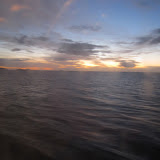 |
| Cabo de Hornos - Cape Horn |
 |
| Wulaia Bay |
 |
| Alacalufe Fjord |
 |
| Magdalena Island Penguin Colony |






